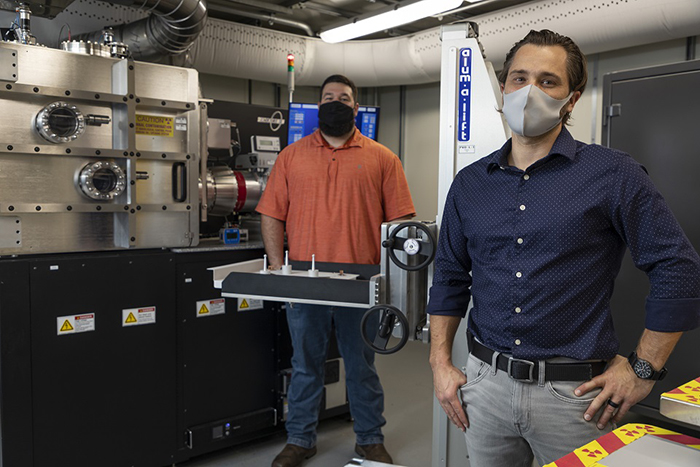| |
The Resurrection Men
May 16, 2021
Y-12 employees use decades-old technology for current application

Jason Steward (left) and Jonathan Peak, Y‑12’s Resurrection Men; image courtesy of DOE |
OAK RIDGE, TN — Call them the Resurrection Men.
Instead of nineteenth century body snatchers who supplied medical schools for anatomy classes, these development engineers brought back a technology that had not been used at Y12 on reactor components since the 1960s.
Jason Steward and Jonathan Peak needed to create a corrosion protective coating for reactor components for a highpriority White Sands Missile Range project. When a tight delivery schedule ruled out other methods, Steward and Peak took a creative look at the past.
“Although thin films and coatings were not why we were hired or what we normally work on, Jonathan’s dissertation focused on thin films and Physical Vapor Deposition processing and my thesis was on corrosion protection coatings/films and subsequent heat treating,” Steward said. “As luck would have it, the both of us combined had the experience to fully develop and execute the project.”
Most of Steward’s work centers on the physical metallurgy and solidification of uranium and uranium alloys. Peak’s work is mostly in material compatibility and surveillance characterization.
“But to do development for a production plant takes a lot of skills, not all of which are learned in school,” Steward said. “And nothing at Y12 is done in a vacuum, so a project takes a lot of different people to be successful.”
“Much of the development was worked out in discussion between the two of us,” Peak explained. “Jason also handled almost all of the programmatic interaction on the project where many decisions had to be made without complete information. He has expertise with the entire process starting with the casting, so that gave important context and perspective to our work. He was also part of CareerOne, which helped greatly when we needed to know who to call when we needed help in certain areas.”
Steward laughingly said he believes he was “probably voluntold” to work on the project while Peak got involved “during the Plant Directed Research and Development call for coatings where he pitched the idea of utilizing PVD.”
That design pitch for the threeyear coating project wound up adding extra travel and lots of weekend work, missed holidays, and time away from their families to the engineers’ regular jobs. “Oh, and we both have fiveyearold sons and had a pregnant wife at some point during this journey,” Steward said.
Both engineers met a number of times with Don Mattox at Sandia National Laboratories who had invented and developed the process to coat the Godiva reactor components. “He’s approaching 90 years old,” Steward said. “He talked with us and even kindly signed the textbooks we used in school. I think he wrote something like ‘best of luck; you’re gonna need it’.”
“Since time and equipment availability were both limited, a great deal of effort was put into deciding the best path to try,” Peak said. “It paid off in that we actually hit our target film thickness on the very first run.”
In fact, the White Sands Missile Range project required Y12 “to set up a novel facility, purposebuilt to do this operation,” said Randy Dziendziel, senior director, Development. “Many people and organizations supported the approval, purchase, and installation of the equipment and facility so Jason and Jonathan could do their magic and make us all look good.”
“It was definitely a village effort to get those facilities in place and operational, along with all the material moves, security, and support from many members of the Y12 team,” Ken Keith, deputy vice president of Mission Engineering, said. “Projects, production, engineering, infrastructure — people from many groups — did their work so this critical mission work could happen.”
Along with the work happening on site, the two engineers “traveled to the vendor site to test equipment and process to reduce risk and worked many, many hours once the equipment was delivered and installed here at Y12,” Dziendziel said. “There was very little margin in the schedule for testing, so they had to get it right the first time. Much of the testing and subsequent operations were on weekends.”
“During the development phase, the plant was in quarantine, so special approvals were required to begin processing,” Steward said. “The biggest challenge was the compressed schedule to develop the coating and heat treatment process. Development experimental plans are normally comprised of a multisite and multiyear effort to progress the technology to production. In this scenario, we only had three development runs before the first production run. After the last development run, there were still issues to be resolved during the production run.”
Steward and Peak said they probably worked 90 hours during the week of the first production run.
“But these are the kinds of projects that are exciting, with high stakes and high relevancy,” Peak said. “We got to see the output, the results of our development work.”
Steward agreed. “After visiting the White Sands Missile Range and understanding the importance of the reactor’s role in the strategic mission, we are both just glad we got to be a little part in the large effort carried out by Y12 employees.”
Consolidated Nuclear Security, LLC operates the Pantex Plant, located in Amarillo, Texas, and the Y-12 National Security Complex, located in Oak Ridge, Tennessee, under a single contract for the U.S. National Nuclear Security Administration. CNS member companies include Bechtel National, Inc.; Leidos, Inc.; ATK Launch Systems, Inc.; and SOC LLC. Pantex and Y-12 are key facilities in the U.S. Nuclear Security Enterprise, and CNS performs its work with a focus on performance excellence and the imperatives of safety, security, zero defects and delivery as promised.
For more information on each site, visit www.pantex.energy.gov or www.y12.doe.gov.
|

